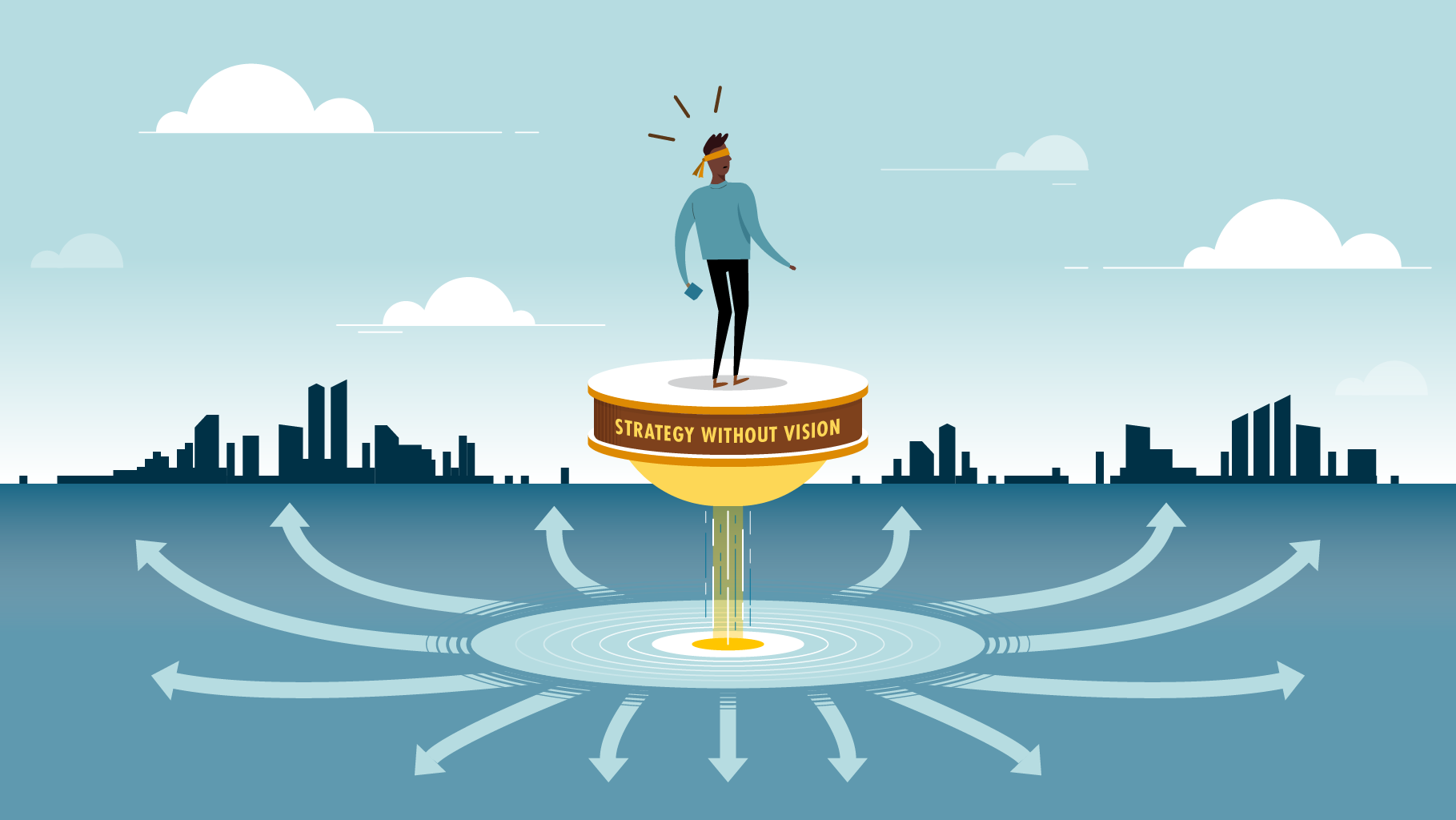A compelling vision of the future can inform much more than just your next strategic plan. In fact, it’s critical to success in more than one scenario.
If you don’t know where you are going, you might end up someplace else. –Yogi Berra
Here’s an eye-opener: According to McKinsey, 74% of executives don’t believe their strategic initiatives will succeed. That’s an astounding three out of every four leaders. Considering the amount of time, sweat, and sticky notes it took to develop those initiatives, what are these organizations missing that would increase the likelihood of success?
How Vision Contributes to Success
Writing in Inc. last year, Tanya Prive suggested these strategies fail because they aren’t tied to a vision.*
Many planning teams start with an assessment of a current state before establishing what the organization wants its future to be. Prive feels this is backwards—that establishing a future vision is a critical initial step that gives planners an outcome to work toward as they consider strategic or transformational initiatives.
This is also how XPLANE approaches strategic planning. In fact, it’s how we approach many of the initiatives we help our clients create and execute.
By establishing a clear, compelling vision of the future, we help organizations align toward an aspirational goal everyone can see and agree upon.
Four Ways to Leverage Your Vision
Visioning is a powerful tool, and a fully developed vision has more applications than many people realize.
Beyond anchoring your strategy, we can think of at least four scenarios in which a fully developed vision can impact your organization for the better.
#1: You need a filter for decision-making
Even the most disciplined organizations can struggle when it comes to making decisions.
Perhaps the organizational culture holds that more input is better, and getting multiple layers of stakeholders to weigh in on a decision in a timely manner is difficult. Or maybe no one wants to have to take responsibility should a new initiative not work out, so people do whatever they can to avoid making the decision to implement it in the first place.
Even if your decision-making process and protocol are well defined and adhered to, unforeseen events can arise—a global pandemic, for instance—that make timely decisions very, very difficult.
A fully formed and accepted vision of the future can help an organization determine how to address decisions more quickly and effectively. When faced with a critical decision, it can help to pose a straightforward question: “Will this help us achieve our vision?”
This places near-term consequences in the context of long-term goals and often makes decisions crystal clear.
#2: You need a reason for people to engage
Let’s face it: The days of gold watches signifying long-term employment are long past. Employees today move jobs according to salary, benefits, flexibility, and opportunities available to them.
This can be an expensive proposition, because it can be more costly to recruit new employees than it is to keep existing ones. Keeping employees engaged has never been more important.
One clear way to do this is to show employees a compelling picture of a future they can be part of.
Purpose-driven organizations learned long ago that people will align with a direction that supports their ideals and self-identity. Today, especially as we look to build hybrid work models, we must pay attention to how employees see themselves at work and what they need to support their own career and goals.
An aspirational vision of a future they can work toward can give them the frame of reference they need.
#3: You need a basis for your value proposition
Anyone who provides a product or service to a customer—essentially, anyone reading this—understands how important it is to convince customers what they offer has value. This is the most basic, foundational element of marketing that exists.
About ten years or so ago, a man named Simon Sinek burst onto the TED scene with his contention that why you do what you do has as much value to your customer as the product or service you are trying to sell.
“People don’t buy what you do,” he famously said, “they buy why you do it.”
A thoughtful vision can be a key element of any organization’s value proposition. It automatically frames the work you do as in pursuit of a specific future outcome and gives customers the same opportunity to align with you as it gives to employees.
When paired with a description of how customers will benefit from your product or service, a purposeful, concrete vision can align your value proposition with your customers’ aspirations as well as yours.
#4: You need an incentive for people to accept and adopt change
One of the most difficult and important transitions for any organization to make today is to fully adapt to a new way of doing something.
At XPLANE we are often asked by our clients to help them activate changes within their organization. One of the critical steps we have found in that process of establishing change is giving employees a way to see themselves in the future state—in other words, what their work will look like in the future. And the best way to do that is to create a crystal clear vision of that future.
Humans don’t typically want to change their behavior unless they have a really, really good reason to do so. In organizations, those reasons are often determined by people other than the employees who will have to change their ways of working.
This disconnect dooms many change efforts.
Showing employees a vision of how the new way of working will improve their process or experience—in other words, what’s in it for them—can make all the difference in a successful change initiative.
Put the Future First
An organization’s vision of the future it is trying to create is perhaps the most important element of any planning effort. The clarity of intent and direction it provides makes many strategic initiatives possible. Without it, they are doomed to fail.
So the next time you’re preparing to tackle such a transformational effort, start by thinking about the future first.
For Further Reading
Want to learn more about creating and using a well-thought-through vision in your organization?
We recommend the following resources:
- Into Thin Air: How Good Leaders Share Their Vision and Inspire Action
- How Does a Diverse Community Come Together to Create a Single Vision of the Future?
- Five Steps to Transforming the Customer Experience and Accelerating Growth
And don’t hesitate to reach out to us if you have questions or comments on this post!
*Prive, Tanya. “Why 67 Percent of Strategic Plans Fail.” Inc., 23 Oct 2020, https://www.inc.com/tanya-prive/why-67-percent-of-strategic-plans-fail.html

How Design Thinking Can Help You Achieve Strategic Agility
In today’s dynamic world, an effective strategy must keep pace with change. Here’s how you can create all-important strategic agility and reach your goals faster.

Rethinking Customer Centricity in the Post-Pandemic Era
The world has shifted in the past few years, and organizations that wish to remain vital now more than ever must focus on the customer

Strategy Execution Needs Human-Centered Design: Five Steps to Turn Plans into Action
Strategies that are launched with a complex presentation and “cascaded” down the ranks are bound to fail. We no longer live in a world of
